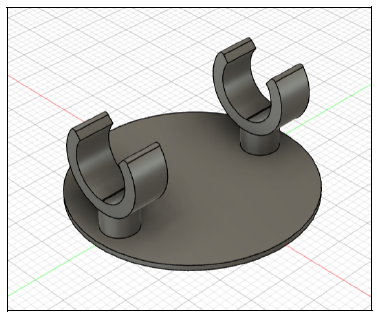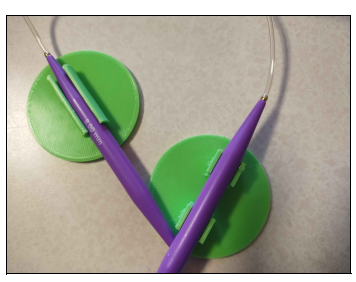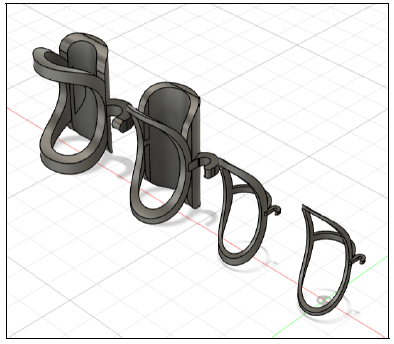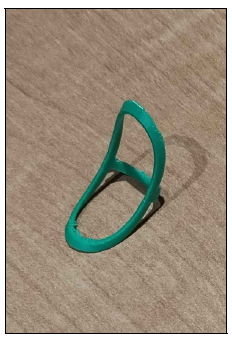KnitGrip: An Arthritic Assistive Device for Knitting
A design brief from:
Mira Yeoh | miramy@vt.edu
Additional Authors: Delara Bahrambeigui, Dianne Barahona Bonilla, Alexis, Hamilton, Braxton McDaniel, Haaris Mallick, Lily Quach, Micah Wissman, and Ryan Williams
Affiliated with Archimedes at Virginia Tech Undergraduate Engineering Program
2/21/2025
Background
Arthritis is an inflammatory disease that is characterized by the swelling of body tissue and limited movement in the joints, affecting the performance of day-to-day activities for those diagnosed with it ("Arthritis"). It has become one of the leading causes of disability of fine motor functions in adults, with the disease being prevalent in 18.9% of those aged 18 and older in 2022. In addition to this, women (21.5%) were observed to be more likely to have arthritis than men (16.1%), and the prevalence of arthritis has also increased with an aging population, going from 3.9% in adults aged 18-34 to 53.9% in adults aged 75 and up (Elgaddal et al.). With impairments in fine motor function and increased prevalence of arthritis, it becomes increasingly difficult for adults to perform leisurely activities that require precise movements of the hands. One activity that commonly requires these fine motor functions is knitting, which consists of repeatedly interconnecting loops of yarn by the fingers. Arthritis makes knitting difficult to perform due to stiffness in the joints and decreased grip strength by the hands to hold knitting needles in place. There are available treatment options that attempt to alleviate the symptoms of arthritis for knitters, such as finger splints and compression gloves. Finger splints are used to immobilize the fingers to improve alignment in affected joints and to reduce pain ("Splints"), and compression gloves apply pressure to the hand when worn by the user to remove extracellular fluids to decrease swelling and improve hand function (Prior et al.). While these treatment options are available, there are few devices specifically created for knitters in mind on the market. The primary objective of this design project is to develop a customized 3D-printed splint combined with a compression glove and knitting needle grips to increase performance and finger stability for knitters with arthritis, as well as to improve comfort and fine motor movement in the user.
Design Approach
Several design iterations have been undertaken throughout the engineering process. Initial designs included a compression glove to be worn by users with grip supports attached to the palm for aligning the knitting needles. Grip support designs resembled small tubes that extended to the base of the palm for fitting and holding knitting needles. A finger splint for the index finger was included in the design to improve finger alignment when knitting. Grip supports and finger splints were developed with computer-aided design software and iterated multiple times to adjust for needle and finger dimensions, then 3D printed for testing. Despite the iterations, knitting needles for testing were not able to fit through grip supports, as needles were difficult to take out of the grips.

A second design iteration for grip supports was created to resemble Lego minifigure hands, with two hands attached on a circular plate meant to be put on the compression glove palm. The knitting needle would be held on two ends to improve grip support for the user.


Finger splints went through several iterations to adjust for the thickness of the splint's exterior. Initial finger splint models were designed to include a thin exterior, however, a 3D printed version of the model snapped when worn for testing. The splint's exterior was adjusted to enhance durability, however, the model was loose around the finger when worn. Finally, a thicker version of the splint was designed and printed to adjust for looseness and durability. It additionally includes an ovular base to support finger joints for improved alignment.


Final Design
KnitGrip's final design consists of two compression gloves with knitting needle grips attached to each palm, which are held in place with magnets that are glued to the palm's exterior, as well as one finger splint to be worn on the index finger of the user.

Outcome
The primary goal of this project is to develop a low-cost, user-friendly, and effective arthritic assistive device to be used in knitting communities. Device testing has been limited to team members during the development process, as finger splint dimensions and compression glove sizes need to be adjusted for additional users. However, the knitting application consists of a plastic clip, or knitting needle grips, that allows for a needle to snap in and out and to be held securely with minimal muscle use, allowing for a natural knitting motion.
Cost
The device makes use of several components that include a combination of items purchased online, as well as 3D printed components developed through computer-aided design software from scratch. The expected pricing of our product is $35; magnets that attach to the knitting needle grips cost $15.00, and compression gloves that were used cost $20.00. 3D models were printed free of charge through the university's 3D printers.
Significance
KnitGrip allows those struggling with degenerative musculoskeletal diseases to knit while minimizing pain and difficulty of movement. By bracing the support finger and holding knitting needles in the palm using mechanical devices, knitters with arthritis can enjoy a common pastime for an affordable price. Although the device is primarily used for knitting, for future iterations, we plan to diversify the usage of the needle grip to serve as an interchangeable magnetic accessory, allowing for additional applications ranging from knitting to gripping other common utensils, such as those used for eating or writing. We also hope to expand testing in the future, extending the use of our device to local community centers and knitting clubs.
References
- "Arthritis." Johns Hopkins Medicine, www.hopkinsmedicine.org/health/conditions-and-diseases/arthritis.
- Elgaddal, Nazik, et al. "Arthritis in Adults Age 18 and Older: United States, 2022." Centers for Disease Control and Prevention, Centers for Disease Control and Prevention, 29 Feb. 2024, www.cdc.gov/nchs/products/databriefs/db497.htm.
- Prior, Yeliz, et al. "Does Wearing Arthritis Gloves Help with Hand Pain and Function? A Qualitative Study into Patients' Views and Experiences." Rheumatology Advances in Practice, U.S. National Library of Medicine, 12 Feb. 2022, pmc.ncbi.nlm.nih.gov/articles/PMC8883590/.
- "Splints and Braces." The Arthritis Society, 2018, arthritis.ca/support-education/online-learning/daily-living/splints-and-braces.